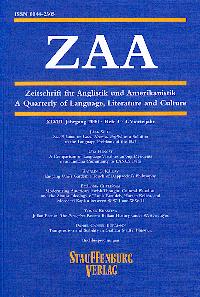|
Aus dem Inhalt
Aus dem
Inhalt:
- Jörg Witt: Nuntii
Latinior Latest
News in English as a Solution to the Language Problems of the EU?
- Uta Hengst: A Comparison of Language Variables among Residents in an Indiana Community to
LANCS Data (abstract)
- Katalin G. Kallay: Envying
One’s Garden: A Touch of Rappaccini’s Philosophy
- Bozenna Chylinska: Modernizing
American Jewish Thought: Cultural Pluralism and the Zionist Ideology of
Louis Brandeis, Horace Kallen, and Mordecai Kaplan Between WW I and WW II (abstract)
- Yonka Krasteva: Julian
Barnes’s The Porcupine: A
Portrait of the Artist as Cultural Historian (abstract)
- Daniel Candel Bormann: Transgression
and Stability in Graham Swift’s Waterland
(abstract)
Miszelle:
Kultur erzählen – Zwei Geschichten englischer/britischer Kultur
Buchbesprechungen:
- Graham Seal. The Lingo:
Listening to Australian English. (Gerhard Leitner)
- Wolfgang Obst/Florian Schleburg. Die Sprache Chaucers: Ein Lehrbuch des
Mittelenglischen. and Jeremy J. Smith. Essentials
of Early English. (Fritz
Kemmler)
- Rudolf Beck/Hildegard Kuester/Martin Kuester. Terminologie der
Literaturwissenschaft. (Karl-Heinz
Stoll)
- Lorna Sage, ed. Cambridge
Guide to Women’s Writing in English. (Ina
Schabert)
- Iain McCalman, gen. ed.
An Oxford Companion to the Romantic Age: British Culture 1776-1832. (Marion
Spies)
- Bianca Ross. Britannia
et Hibernia: Nationale und kulturelle Identität im Irland des 17.
Jahrhunderts. (Michaela Schrage)
- Gillian Skinner.
Sensibility and Economics in the Novel, 1740-1800. (Walter
Göbel)
- M.A.R. Habib. The Early T.S. Eliot and Western Philosophy. (Rudolf
Germer)
- Cecile Sandten. Broken Mirrors: Interkulturalität am Beispiel der
indischen Lyrikerin Sujata Bhatt. (Martina
Ghosh-Schellhorn)
- Klaus J. Milich. Die frühe Postmoderne: Geschichte eines europäisch-amerikanischen
Kulturkonflikts. (Brigitte
Georgi-Findlay)
- Lavina Dhingra Shankar/Rajini Srikanth, eds. A
Part, Yet Apart: South Asians in Asian America.
(Mita
Banerjee)
- C.K. Doreski. Writing
America Black: Race Rhetoric in the Public Sphere. (Donato
Wharton)
- Melissa Dabakis. Visualizing
Labor in American Sculpture. (Stefan
L. Brandt)
Uta Hengst: A Comparison of
Language Variables among Residents in an Indiana Community to LANCS Data
This
article is a small-scale dialectological study of the rural community of
Lanesville at the Southern border of Indiana, conducted in summer 1995. The
collected data was compared to the material of the Linguistic
Atlas of the North Central States (LANCS) where available, first, in order
to plot existing language change in Southern Indiana since the time of the LANCS
fieldwork and thus determining which dialect features prevail in the language of
this community, and second, to explore to what extent age and sex of the
informants are distinguishing factors for the items investigated in the study. A
short description of the dialect areas of the Midwest as defined by Frazer,
Carver, Dakin et al. is given. The paper describes LANCS and focuses on its
history, possibilities and deficits, before presenting the investigated
community and the methods applied in the study.
Bozenna Chylinska: Modernizing
American Jewish Thought: Cultural Pluralism and the Zionist Ideology of
Louis Brandeis, Horace Kallen, and Mordecai Kaplan Between WW I and WW II
The image of American society that emerges from a careful study of the racial,
religious, and nationality groups in the United States reveals a complex social
organization, described under such terms as "assimilation," "acculturation,"
"melting pot," "pluralism." While Anglo-conformity has been
the most prevalent ideology of assimilation in the American experience, a
competing viewpoint of "Melting Pot" was formulated in 1908 by Israel
Zangwill. The classic statement of the cultural pluralist position was made in
1915 by Horace Kallen who elaborated on the theme of American multiple group
life, and strongly rejected the assimilationist theories. For Kallen, an
American Jew, the most useful movement for revitalizing Jewish consciousness was
Zionism, and the most important Zionists - Louis Brandeis and Mordecai Kaplan.
Under the influence of the contemporary American debates of multiculturalism,
and pragmatism, Brandeis, Kallen, and Kaplan "legitimized" Jews in
America, and defined Zionism as the key element in harmonizing the process of
Americanization with reviving Jewish consciousness.
Yonka Krasteva: Julian
Barnes’s The Porcupine: A
Portrait of the Artist as Cultural Historian
My aim in this
paper is to determine whether in The
Porcupine Julian Barnes has been able to extricate himself from past
stereotypes in the representations of the Balkans, such as
the ‘vampire sagas’ and thrillers, and has developed new modalities
for ‘reading’ the new historical developments.
The novel focuses on the televised trial of the deposed dictator, Stoyo
Petkanov, and his off-stage encounters with his adversary, the Prosecutor
General, Peter Solinski, who is supposed to stand for the ‘brave new world’
of emergent Bulgarian democracy. Stoyo Petkanov is troped in the familiar
vampire rhetoric while at the end of the novel, Solinski tries to wrench himself
from the “monster’s” grasp and feels “stained, contaminated, sexually
corrupted, irradiated to the bone marrow.”
There is a deliberate staginess and
a feigned theatricality of gesture and intent which are supposed to
render the whole of a complex,
uneasy national life before a
figurative camera. The major requirement in the text seems to be neither
exactitude of knowledge, nor depth of penetration, but coherence, the
positioning of the work within a recognisable body of cultural writing on the
subject of Southeastern Europe.
Daniel Candel
Bormann: Transgression
and Stability in Graham Swift’s 'Waterland'
The present article analyses the appearance of two related themes - science and
history - in Graham Swift’s Waterland. The starting hypothesis of this article is that, since
the meanings of history and science converge to a large extent, the joint
appearance of these two themes in the novel will exert pressures on the
presentation of each of them. After pointing out the shared meaning of science
and history, the article will try to show how - notwithstanding the reductive
presentation of science in the novel - this pressure results in a creative
interplay between stability and transgression, appropriation and alienation,
which is characteristic of historiographic metafiction.
|


